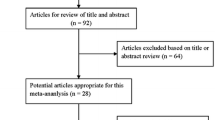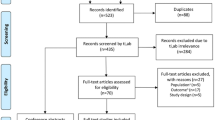Abstract
Aim of the review To systematically analyze the efficacy and safety of liraglutide for the treatment of diabetes mellitus in comparison to other mono- and combination therapies. Method PubMed (any date) and EMBASE (all years) search was conducted with liraglutide as a search term. Phase III clinical trials retrieved by the two databases and resources posted in Drug@FDA website were evaluated with regard to outcomes of efficacy and safety. Results Eight Phase III clinical studies compared the efficacy and safety of liraglutide to other monotherapies or combinations. Liraglutide as monotherapy in doses of 0.9 mg or above showed a significantly superior reduction in HbA1C compared to monotherapies with glimepiride or glyburide. When liraglutide was used as add-on therapy to glimepiride in doses of 1.2 mg or above, the reduction of HbA1C was greater than that in the combination therapy of glimepiride and rosiglitazone. However, liraglutide as add-on therapy to metformin failed to show benefit over combination of metformin and glimepiride. Triple therapy of using liraglutide in addition to metformin plus either glimepiride or rosiglitazone resulted in additional benefit in HbA1C reduction. Most common adverse events were gastrointestinal disturbance such as nausea, vomit, diarrhea, and constipation. During the eight clinical studies, six cases of pancreatitis and five cases of cancer were reported in liraglutide arm, whereas there was one case of each of pancreatitis in exenatide and glimepiride arms, respectively, and one case of cancer in metformin plus sitagliptin arm. Conclusion Liraglutide is a new therapeutic option to improve glycemic control in patients with type 2 diabetes. However, the present lack of evidence of durability of efficacy and long-term safety appear to limit its utility in the general treatment of type 2 diabetes at this time.

Similar content being viewed by others
References
Merani S, Truong W, Emamaullee JA, Toso C, Knudsen LB, Shapiro AM. Liraglutide, a long-acting human glucagon-like peptide 1 analog, improves glucose homeostasis in marginal mass islet transplantation in mice. Endocrinology. 2008;149:4322–8.
Russell-Jones D. Molecular, pharmacological and clinical aspects of liraglutide, a once-daily human GLP-1 analogue. Mol Cell Endocrinol. 2009;297:137–40.
Lin F, Wang R. Molecular modeling of the three-dimensional structure of GLP-1R and its interactions with several agonists. J Mol Model. 2009;15:53–65.
Mari A, Degn K, Brock B, Rungby J, Ferrannini E, Schmitz O. Effects of the long-acting human glucagon-like peptide-1 analog liraglutide on beta-cell function in normal living conditions. Diabetes Care. 2007;30:2032–3.
Clinical pharmacology biopharmaceutics review. http://www.accessdata.fda.gov/drugsatfda_docs/nda/2010/022341s000clinpharmr.pdf. Accessed 26 Apr 2011.
Friedrichsen BN, Neubauer N, Lee YC, Gram VK, Blume N, Petersen JS, et al. Stimulation of pancreatic beta-cell replication by incretins involves transcriptional induction of cyclin D1 via multiple signalling pathways. J Endocrinol. 2006;188:481–92.
Barnett AH. New treatments in type 2 diabetes: a focus on the incretin-based therapies. Clin Endocrinol (Oxf). 2009;70:343–53.
Chemistry review. http://www.accessdata.fda.gov/drugsatfda_docs/nda/2010/022341s000chemr.pdf. Accessed 26 Apr 2011.
Irie S, Matsumura Y, Zdravkovic M, Jacobsen LV, Kageyama S. Tolerability, pharmacokinetics and pharmacodynamics of the once-daily human GLP-1 analog liraglutide in Japanese healthy subjects: a randomized, double-blind, placebo-controlled dose-escalation study. Int J Clin Pharmacol Ther. 2008;46:273–9.
Malm-Erjefalt M, Bjørnsdottir I, Vanggaard J, Helleberg H, Larsen U, Oosterhuis B, et al. Metabolism and excretion of the once-daily human glucagon-like peptide-1 analog liraglutide in healthy male subjects and its in vitro degradation by dipeptidyl peptidase IV and neutral endopeptidase. Drug Metab Dispos. 2010;38:1944–53.
Meece J. Pharmacokinetics and pharmacodynamics of liraglutide, a long-acting, potent glucagon-like peptide-1 analog. Pharmacotherapy. 2009;29(12 Pt 2):33S–42S.
Grossman S. Differentiating incretin therapies based on structure, activity, and metabolism: focus on liraglutide. Pharmacotherapy. 2009;29(12 Pt 2):25S–32S.
Davidson JA. Incorporating incretin-based therapies into clinical practice: differences between glucagon-like Peptide 1 receptor agonists and dipeptidyl peptidase 4 inhibitors. Mayo Clin Proc. 2010;85(12 Suppl):S27–37.
Joffe D. Liraglutide: a once-daily human glucagon-like peptide-1 analogue for type 2 diabetes mellitus. Am J Health Syst Pharm. 2010;67:1326–36.
Tzefos M, Olin JL. Glucagon-like peptide-1 analog and insulin combination therapy in the management of adults with type 2 diabetes mellitus. Ann Pharmacother. 2010;44:1294–300.
Drab SR. Incretin-based therapies for type 2 diabetes mellitus: current status and future prospects. Pharmacotherapy. 2010;30:609–24.
Garber A, Henry R, Ratner R, Garcia-Hernandez PA, Rodriguez-Pattzi H, Olvera-Alvarez I, et al. Liraglutide versus glimepiride monotherapy for type 2 diabetes (LEAD-3 Mono): a randomised, 52-week, phase III, double-blind, parallel-treatment trial. Lancet. 2009;373:473–81.
Garber A, Henry RR, Ratner R, Hale P, Chang CT, Bode B, et al. Liraglutide, a once-daily human glucagon-like peptide 1 analogue, provides sustained improvements in glycaemic control and weight for 2 years as monotherapy compared with glimepiride in patients with type 2 diabetes. Diabetes Obes Metab. 2011;13:348–56.
Seino Y, Rasmussen MF, Nishida T, Kaku K. Efficacy and safety of the once-daily human GLP-1 analogue, liraglutide, vs glibenclamide monotherapy in Japanese patients with type 2 diabetes. Curr Med Res Opin. 2010;26:1013–22.
Marre M, Shaw J, Brandle M, Bebakar WM, Kamaruddin NA, Strand J, et al. Liraglutide, a once-daily human GLP-1 analogue, added to a sulphonylurea over 26 weeks produces greater improvements in glycaemic and weight control compared with adding rosiglitazone or placebo in subjects with Type 2 diabetes (LEAD-1 SU). Diabet Med. 2009;26:268–78.
Nauck M, Frid A, Hermansen K, Shah NS, Tankova T, Mitha IH, et al. Efficacy and safety comparison of liraglutide, glimepiride, and placebo, all in combination with metformin, in type 2 diabetes: the LEAD (liraglutide effect and action in diabetes)-2 study. Diabetes Care. 2009;32:84–90.
Pratley RE, Nauck M, Bailey T, Montanya E, Cuddihy R, Filetti S, et al. Liraglutide versus sitagliptin for patients with type 2 diabetes who did not have adequate glycaemic control with metformin: a 26-week, randomised, parallel-group, open-label trial. Lancet. 2010;375:1447–56.
Pratley R, Nauck M, Bailey T, Montanya E, Cuddihy R, Filetti S, et al. One year of liraglutide treatment offers sustained and more effective glycaemic control and weight reduction compared with sitagliptin, both in combination with metformin, in patients with type 2 diabetes: a randomised, parallel-group, open-label trial. Int J Clin Pract. 2011;65:397–407.
Buse JB, Rosenstock J, Sesti G, Schmidt WE, Montanya E, Brett JH, et al. Liraglutide once a day versus exenatide twice a day for type 2 diabetes: a 26-week randomised, parallel-group, multinational, open-label trial (LEAD-6). Lancet. 2009;374:39–47.
Zinman B, Gerich J, Buse JB, Lewin A, Schwartz S, Raskin P, et al. Efficacy and safety of the human glucagon-like peptide-1 analog liraglutide in combination with metformin and thiazolidinedione in patients with type 2 diabetes (LEAD-4 Met + TZD). Diabetes Care. 2009;32:1224–30.
Russell-Jones D, Vaag A, Schmitz O, Sethi BK, Lalic N, Antic S, et al. Liraglutide vs insulin glargine and placebo in combination with metformin and sulfonylurea therapy in type 2 diabetes mellitus (LEAD-5 met + SU): a randomised controlled trial. Diabetologia. 2009;52:2046–55.
Pfutzner A, Weber MM, Forst T. A biomarker concept for assessment of insulin resistance, beta-cell function and chronic systemic inflammation in type 2 diabetes mellitus. Clin Lab. 2008;54:485–90.
Prescribing information of Victoza. http://www.accessdata.fda.gov/drugsatfda_docs/label/2010/022341lbl.pdf. Accessed 26 Apr 2011.
Stirban AO, Tschoepe D. Cardiovascular complications in diabetes: targets and interventions. Diabetes Care. 2008;31(Suppl 2):S215–21.
van Dieren S, Beulens JW, van der Schouw YT, Grobbee DE, Neal B. The global burden of diabetes and its complications: an emerging pandemic. Eur J Cardiovasc Prev Rehabil. 2010;17(Suppl 1):S3–8.
Nathan DM, Buse JB, Davidson MB, Heine RJ, Holman RR, Sherwin R, et al. Management of hyperglycemia in type 2 diabetes: A consensus algorithm for the initiation and adjustment of therapy: a consensus statement from the American Diabetes Association and the European Association for the Study of Diabetes. Diabetes Care. 2006;29:1963–72.
International Diabetes Federation. Global guideline for type 2 diabetes. http://www.idf.org/webdata/docs/IDF%20GGT2D.pdf. Accessed 26 Apr 2011.
Rodbard HW, Jellinger PS, Davidson JA, Einhorn D, Garber AJ, Grunberger G, et al. Statement by an American Association of Clinical Endocrinologists/American College of Endocrinology consensus panel on type 2 diabetes mellitus: an algorithm for glycemic control. Endocr Pract. 2009;15:540–59.
Resnick HE, Foster GL, Bardsley J, Ratner RE. Achievement of American Diabetes Association clinical practice recommendations among US adults with diabetes, 1999–2002: the National Health and Nutrition Examination Survey. Diabetes Care. 2006;29:531–7.
Pogach L, Engelgau M, Aron D. Measuring progress toward achieving hemoglobin A1c goals in diabetes care: pass/fail or partial credit. JAMA. 2007;297:520–3.
Redmond EH, Burnett SM, Johnson MA, Park S, Fischer JG, Johnson T. Improvement in A1C levels and diabetes self-management activities following a nutrition and diabetes education program in older adults. J Nutr Elder. 2006;26:83–102.
Kothare PA, Linnebjerg H, Isaka Y, Uenaka K, Yamamura A, Yeo KP, et al. Pharmacokinetics, pharmacodynamics, tolerability, and safety of exenatide in Japanese patients with type 2 diabetes mellitus. J Clin Pharmacol. 2008;48:1389–99.
Bjerre Knudsen L, Madsen LW, Andersen S, Almholt K, de Boer AS, Drucker DJ, et al. Glucagon-like peptide-1 receptor agonists activate rodent thyroid C-cells causing calcitonin release and C-cell proliferation. Endocrinology. 2010;151:1473–86.
Pharmacology review. http://www.accessdata.fda.gov/drugsatfda_docs/nda/2010/022341s000pharmr_P1.pdf. Accessed 26 Apr 2011.
Medical review. http://www.accessdata.fda.gov/drugsatfda_docs/nda/2010/022341s000medr_P1.pdf. Accessed 26 Apr 2011.
University of Utah Hospitals & Clinics. New drug bulletin: liraglutide [rDNA origin] injection (Victoza-Novo Nordisk). http://healthcare.utah.edu/pharmacy/bulletins/NDB_213.pdf. Accessed 26 Apr 2011.
Acknowledgments
The authors would like to thank Dr. Hye-Yoon Choi for her assistance with data collection and analysis for this paper.
Funding
This research was supported by the Yeungnam University research grants in 2010.
Conflicts of interest
The authors have no conflicts of interest to declare.
Author information
Authors and Affiliations
Corresponding author
Rights and permissions
About this article
Cite this article
Jeong, KH., Yoo, B.K. The efficacy and safety of liraglutide. Int J Clin Pharm 33, 740–749 (2011). https://doi.org/10.1007/s11096-011-9552-8
Received:
Accepted:
Published:
Issue Date:
DOI: https://doi.org/10.1007/s11096-011-9552-8




